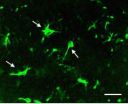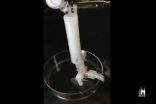(Press-News.org) Transforming growth factor-beta (TGF-β) type II receptor (TβRII) levels are extremely low in the brain tissue of patients with Alzheimer's disease. This receptor inhibits TGF-β1/SMAD signaling and thereby aggravates amyolid-beta deposition and neuronal injury. Dab2, a specifc adapter protein, protects TβRII from degradation and ensures the effective conduction of TGF-β1/SMAD signaling. Prof. Jun Liu and team from Norman Bethune First Hospital of Jilin University in China used an adenoviral vector to overexpress Dab2 in the APP/PS1 transgenic mouse model of Alzheimer's disease, and investigated the regulatory effect of Dab2 protein on transforming growth factor-β1/SMAD signaling and brain injury in Alzheimer's disease. They found that after Dab2 expression, hippocampal TβRII and p-SMAD2/3 levels were significantly increased, while amyloid-beta deposition, microglia activation, tumor necrosis factor-β and interleulin-6 levels and neuronal loss were signifcantly attenuated in APP/PS1 mouse brain tissue. These findings, published in the Neural Regeneration Research (Vol. 9, No. 1, 2014), suggest that Dab2 can exhibit neuroprotective effects in Alzheimer's disease by regulating TGF-β1/SMAD signaling.
INFORMATION:
Article: " Dab2 attenuates brain injury in APP/PS1 mice via targeting transforming growth factor-beta/SMAD signaling" by Lei Song1, Yue Gu2, Jing Jie2, Xiaoxue Bai2, Ying Yang2, Chaoying Liu2, Qun Liu1 (1 Department of Neurology, Norman Bethune First Hospital of Jilin University, Changchun, Jilin Province, China; 2 Department of Respiratory Medicine, Norman Bethune First Hospital of Jilin University, Changchun, Jilin Province, China)
Song L, Gu Y, Jie J, Bai XX, Yang Y, Liu CY, Liu Q. Dab2 attenuates brain injury in APP/PS1 mice via targeting transforming growth factor-beta/SMAD signaling. Neural Regen Res. 2014;9(1):41-50.
Contact: Meng Zhao
eic@nrren.org
86-138-049-98773
Neural Regeneration Research
http://www.nrronline.org/
Dab2: How to attenuate brain injury due to Alzheimer's disease?
2014-03-25
ELSE PRESS RELEASES FROM THIS DATE:
The causes and consequences of global climate warming that took place 56 million years ago studied
2014-03-25
The growing and justified concern about the current global warming process has kindled the interest of the scientific community in geological records as an archive of crucial information to understand the physical and ecological effects of ancient climate changes. A study by the UPV/EHU's Palaeogene Study Group deals with the behaviour of the sea level during the Palaeocene–Eocene Thermal Maximum (PETM) 56 million years ago and has ruled out any connection. The study has been published in the journal Palaeogeography, Palaeoclimatology, Palaeoecology.
"The fall in sea ...
A non-invasive, rapid screening method for Alzheimer's disease
2014-03-25
The apolipoprotein E gene ε4 allele is considered a negative factor for neural regeneration in late-onset Alzheimer's disease cases. Apolipoprotein E genotyping is crucial to apolipoprotein E polymorphism analysis. Peripheral venous blood is the conventional tissue source for apolipoprotein E genotyping polymorphism analysis. Blood yields high-quality genomic DNA and can meet various research purposes. However, because of invasiveness, taking blood samples decreases compliance among the elderly, especially neuropsychiatric patients. Moreover, blood specimens often ...
Small peptides as potential antibiotics
2014-03-25
Drug approval requires a deep understanding of the mechanism of action
The team of Julia Bandow, who heads the RUB's Junior Research Group Microbial Antibiotic Research, has been studying the MP196 peptide as a representative of a group of very small positively charged peptides that consist of some four to ten amino acids. Earlier studies had shown that MP196 is efficient against various bacteria, including particularly problematic multi-resistant pathogens that frequently cause sepsis. How MP196 kills bacteria remained unclear. However, in order for a new substance to ...
VTT: Building to take note of individual human thermal comfort
2014-03-25
Because people in developed countries spend about 90% of their time indoors, their sense of warmth becomes one key comfort factor for interior spaces. VTT Technical Research Centre of Finland has developed a new method for assessing the individual thermal comfort experienced by different user groups. The design of energy efficient buildings – such as day care centres, schools, offices and homes for the elderly – should pay more attention in future to the thermal comfort of user groups according to real needs.
The new method developed for assessing thermal comfort (Human ...
Simple, like a neutron star
2014-03-25
In how many ways can one describe an object? Take an apple: by just looking at it we can easily estimate its weight, shape and colour but we are unable to describe it at any other level, for example, to evaluate the chemical composition of its flesh. Something similar also applies to astronomical objects: until today one of the challenges facing scientists was to describe neutron stars at the nuclear physics level. The matter these stars are made up of is in fact extremely complex, and several complicated equations of state have been proposed. However, to date there is ...
New technique brings us closer to HIV and Hepatitis C vaccines
2014-03-25
Plans for a new type of DNA vaccine to protect against the deadly HIV and Hepatitis C viruses have taken an important step forward, with University of Adelaide researchers applying for a patent based on groundbreaking new research.
Professor Eric Gowans from the University's Discipline of Surgery, based at the Basil Hetzel Institute at the Queen Elizabeth Hospital, has submitted a patent application for what he describes as a relatively simple but effective technique to stimulate the body's immune system response, thereby helping to deliver the vaccine.
While pre-clinical ...
Catheter innovation destroys dangerous biofilms
2014-03-25
DURHAM, N.C. -- For the millions of people forced to rely on a plastic tube to eliminate their urine, developing an infection is nearly a 100 percent guarantee after just four weeks. But with the help of a little bubble-blowing, biomedical engineers hope to bring relief to urethras everywhere.
About half of the time, the interior of long-term urinary catheters become plagued by biofilms -- structures formed by colonies of bacteria that are extremely difficult to kill. Once established, it is only a matter of time before the biofilm becomes a welcoming host for other, ...
Doxorubicin alone or with ifosfamide for treating soft tissue sarcoma?
2014-03-25
An EORTC study published in The Lancet Oncology does not support administration of intensified doxorubicin and ifosfamide for palliation of advanced soft tissue sarcoma, unless the objective is to shrink the tumor.
Dr. Ian Judson of the Royal Marsden Hospital in London and coordinator of this study says, "Our clinical trial was designed to compare combination treatment with doxorubicin and ifosfamide to treatment with doxorubicin alone, and our results show that the combination chemotherapy did not improve overall survival. So, if the goal of treatment is to control the ...
Leading surgeons warn against media hype about tracheal regeneration
2014-03-25
Beverly, MA, March 24, 2014 – Reports of the two earliest tissue-engineered whole organ transplants using a windpipe, or trachea, created using the patient's own stem cells, were hailed as a breakthrough for regenerative medicine and widely publicized in the press. However, two leading transplant surgeons in Belgium warn of the dangers of media attention, and urge that tracheal bioengineering be demonstrated as both effective and safe before further transplants take place. Their views are published in an Editorial in The Journal of Thoracic and Cardiovascular Surgery, an ...
Research study takes deeper look at the role of gut microbes in the immune system
2014-03-25
LOS ANGELES (March 24, 2014) – New research suggests that gut microorganisms do not merely influence immune cell function, but also support the production of immune cells that form the first line of defense against infection. By understanding the mechanisms responsible for maintaining and replacing immune cells, researchers hope to one day develop targeted therapies to support and boost immune function in humans.
Study investigators from the Regenerative Medicine Institute at Cedars-Sinai collaborated with the Mount Sinai School of Medicine and lead institution — the ...


